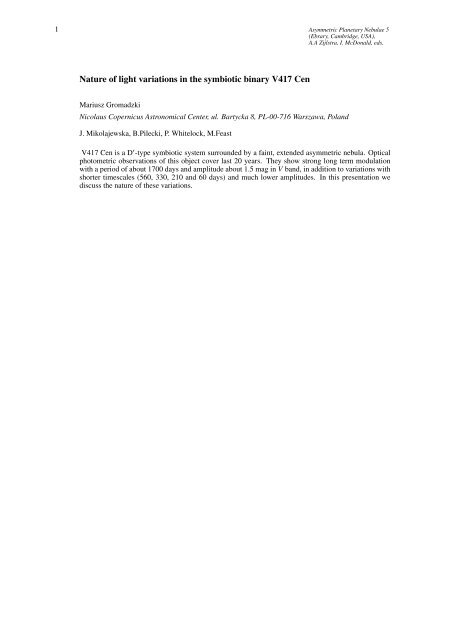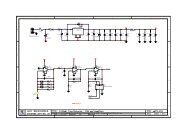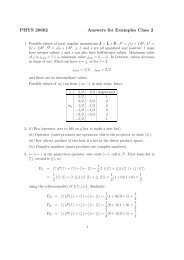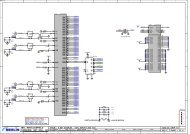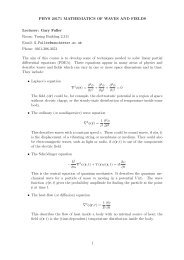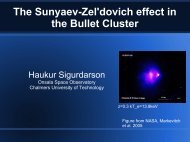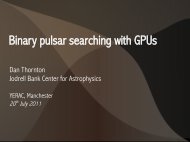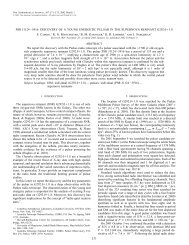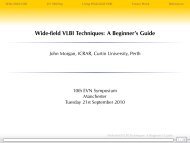Mariusz Gromadzki
Mariusz Gromadzki
Mariusz Gromadzki
Create successful ePaper yourself
Turn your PDF publications into a flip-book with our unique Google optimized e-Paper software.
1 Asymmetric Planetary Nebulae 5<br />
(Ebrary, Cambridge, USA),<br />
A.A Zijlstra, I. McDonald, eds.<br />
Nature of light variations in the symbiotic binary V417 Cen<br />
<strong>Mariusz</strong> <strong>Gromadzki</strong><br />
Nicolaus Copernicus Astronomical Center, ul. Bartycka 8, PL-00-716 Warszawa, Poland<br />
J. Mikolajewska, B.Pilecki, P. Whitelock, M.Feast<br />
V417 Cen is a D ′ -type symbiotic system surrounded by a faint, extended asymmetric nebula. Optical<br />
photometric observations of this object cover last 20 years. They show strong long term modulation<br />
with a period of about 1700 days and amplitude about 1.5 mag in V band, in addition to variations with<br />
shorter timescales (560, 330, 210 and 60 days) and much lower amplitudes. In this presentation we<br />
discuss the nature of these variations.
<strong>Mariusz</strong> <strong>Gromadzki</strong> 2<br />
Abstract<br />
Nature of light variations in the symbiotic binary V 417 Cen<br />
M. <strong>Gromadzki</strong> 1 , J. Mikołajewska 1 , B. Pilecki 2 , P. Whitelock 3,4 , and M. Feast 3,4<br />
1 Nicolaus Copernicus Astronomical Center, Bartycka 18, 00-716 Warsaw, Poland<br />
2<br />
Warsaw University Observatory, Al. Ujazdowskie 4, 00-478 Warsaw, Poland<br />
3 South African Astronomical Observatory, PO Box 9, 7935 Observatory, South Africa<br />
4<br />
Astronomy Department, University of Cape Town, 7701 Rondebosch, South Africa<br />
V 417 Cen is a D'-type symbiotic system surrounded by a faint, extended asymmetric nebula. Optical photometric observations of this object cover last 20 years. They show strong long term modulation with a period of about<br />
1700 days and amplitude about 1.5 mag in V band, in addition to variations with shorter times-cales and much lower amplitudes. In this presentation we discuss possible reasons of these variations.<br />
Introduction<br />
Despite the fact that V 417 Cen is unique even for a D'-type<br />
symbiotic star (only seven such objects are known) and relatively<br />
bright (V ~ 12 m ) it is poorly explored. The symbiotic nature of this<br />
object was proposed by Steiner et al. (1988) but most facts about<br />
this system one can find in Van Winckel et al. (1994). For the cool<br />
companion they derived G2Ib-II, log L/L ⊙ = 3.5, Teff = 5000 K and<br />
log g = 1.50.5. This implies Rg = 75 R⊙ and Mg = 5-7 M⊙. V 417<br />
Cen is associated with a ring nebula (r ≈ 0.4 pc, assuming d ≈ 5<br />
kpc), and more extended (≈ 2.5 pc) remnants of bipolar nebula<br />
(Van Winckel et al. 1994). Zamanov et al. (2006) estimated<br />
v rot sin i = 75 km s -1 , what is 71 % of critical value and implies very<br />
short rotation period Prot ≤ 50.610.2 d.<br />
Photometry<br />
We have collected V-band ASAS photometry (Pojmanski et al.<br />
2002) and visual AAVSO observations. The data cover 2000-<br />
2010. A few measurements from 1986-1993 are found in<br />
Cieslinski et al (1994, 1997). The V-band light curve is shown in<br />
Fig. 1, together with V – I , J – K colours.<br />
V – I colours are taken from ASAS. J – K colours are taken from<br />
different sources: Van Winckel et al. (1994), 2MASS, DENIS and<br />
our observations from SAAO. The colours are transformed to<br />
SAAO photometric system using Carpenter (2001) equations.<br />
Figure 1. The V-band/visual light curve of V 417 Cen. Red crosses represents ASAS data, green times AAVSO data and black dots are taken from<br />
Cieslinski et al. (1994,1997). Blue asterisks represents SAAO data, cyan filled rectangle 2MASS data, red empty triangle DENIS and magenta empty<br />
rectangle is taken from Van Winckel et al. (1994).<br />
Spectrum<br />
Emission spectrum of V 417 Cen is very untypical and variable.<br />
Only few emission lines are present: [O III] 4959, 5007, H, H,<br />
He I 5876, [N II] 6548, 6584. [O III] 5007 is usually the<br />
strongest emission line whereas H is relatively faint and<br />
sometimes absent (Steiner et al., 1988; Cieslinski et al., 1994,<br />
Van Winckel et al., 1993, 1994; Munari & Zwitter, 2002).<br />
The spectrum variation are best illustrated in Van Winckel et al.<br />
(1994). They presented two low resolution spectra obtained in<br />
Feb 1988 and Jan 1993. In 1988 the continuum appeared to be<br />
stronger than in 1993 by a factor 3. In 1993 H was relatively<br />
strong, and its flux was equal to about 2/3 of flux in [O III] 5007.<br />
In Feb 1988 H was very faint, and in Jul 1988 was absent. Such<br />
a behaviour may suggest that the continous spectrum is<br />
dominated by the cool component: the emission lines appear to<br />
become relatively stronger as the continuum decreases.<br />
Another low resolution spectra obtained in Apr 1995 and May<br />
1996 were published by Munari & Zwitter (2002). In 1995 the<br />
continuum appeared to be a factor of 2 fainter than in spectrum<br />
obtained in Feb 1988 by Van Winckel et al. (1994) but emission<br />
lines looked similar. In 1996 the continuum became slightly fainter<br />
(~ 70 %) but intensity of [O III] dramatically decreased and<br />
seemed similar to H.<br />
This suggests that the intrinsic emission line fluxes are poorly<br />
correlated with continuum changes. We suspect that emission<br />
lines are produced mainly by the asymmetric nebula and their<br />
intensity may depend on slit orientation.<br />
Zamanov et al. (private communication) obtained 8 high resolution<br />
spectra during about 100-day period in 2004 (close to the<br />
minimum of the 1700-day period). They found strong variability of<br />
emission lines with time-scales of about 1 month, and no<br />
variability was detected with time-scales of day.<br />
Figure 2. Light curves of V 417 Cen folded with the strongest periods found (left) and corresponding<br />
power spectra (right).<br />
Period analysis<br />
A period search, based on the<br />
modified Lomb-Scargle method<br />
(Press & Rybicki, 1989), was carried<br />
out. Because amplitude of variation is<br />
significant V = 2.3 m , magnitudes are<br />
converted to flux. The period analysis<br />
of ASAS+AAVSO set of data resulted<br />
in a period of P1 = 1698220 days.<br />
Sine curve fitted to this data extended<br />
by measurements from Cieslinski et<br />
al. (1994,1997) gave slightly shorter<br />
period of 165211 days.<br />
The power spectrum of residual light<br />
curve shows P2 = 58224 days. After<br />
removing from the light curve this<br />
period, the power spectrum become<br />
more complicated and shows series<br />
of peaks corresponding to several<br />
periods.<br />
The strongest one is P 3 = 2786 d. It<br />
is worth to notice that P 1 ≈ 3P 2 ≈<br />
6P3. Light curves folded with the<br />
three strongest periods and the<br />
corresponding power spectra are<br />
plotted on Fig. 2. These results do not<br />
agree with historical photographic<br />
observations. Van Winckel et al.<br />
(1994) found a 246-day periodicity<br />
with an amplitude of 0.5 mag, using<br />
magnitudes estimated on 238<br />
Harvard plates, taken between 1919<br />
and 1934, and on 3 Sonneber plates<br />
taken 1959. They interpreted this<br />
periodicity as orbital modulation due<br />
to reflection effect.<br />
Discussion and conclusions<br />
Based on the available observations of V417 Cen, it is hard to<br />
indicate unambiguously causes of its variability. The light curve is<br />
too short with respect to the longest period found P 1 ≈ 1700 d),<br />
and it is even impossible to confirm its coherency. The<br />
measurements from Cieslinski et al. (1994,1997) suggest that it is<br />
not coherent. The continuum changes observed in the spectra<br />
obtained by Munari & Zwitter (2002) do not agree with those<br />
predicted by our fitted sine curve.<br />
We cannot exclude short orbital periods (P2 ≈ 580 d and P3 ≈ 280<br />
d) because time-scale of synchronization is relatively long and<br />
comparable with lifetime of symbiotic stars (syn ≈ 10 5 yr). However<br />
objects surrounded by extended bipolar nebulae usually have long<br />
orbital period, of order of dozens of years, and they are symbiotic<br />
Miras. Zamanov et al. (2006) suggested that the system is<br />
synchronized and the orbital period is equal to ~ 50 d. We can<br />
rather reject such a short period because in this case the cool<br />
giant would fill its Roche lobe and the system should be very<br />
active.<br />
We expect a long orbital period. The period P1 ≈ 1700 d is the<br />
longest detected and we assume that it is the orbital period of<br />
V 417 Cen. In this case, the light changes could be produced by<br />
several mechanisms. We can exclude a modulation due to<br />
reflection effect, because of the high amplitude of variations. Even<br />
systems with more active hot components and smaller separations<br />
do not show such large amplitudes.<br />
References<br />
Angeloni, R., Contini, M., Ciroi, S., and Rafanelli, P. 2007, A&A, 472, 497<br />
Carpenter, J. M. 2001, AJ, 121, 2851<br />
Cieslinski, D., Elizalde, F., and Steiner, J. E. 1994, A&AS, 106, 243<br />
Cieslinski, D., Jablonski, F. J., and Steiner, J. E. 1997, A&AS, 124, 55<br />
In symbiotic binaries two kinds of light variations caused by<br />
accretion rate changes can be observed. The first one is due to<br />
enhanced accretion during periastron passage in systems with<br />
elliptical orbit. System with long period tend to have eccentric<br />
orbits (e.g. BXMon, MWC 560, CD-43 14 304) but a weak point of<br />
this explanation is strong tidal interaction, which relatively fastly<br />
slows down rotation of the cool component. The second possibility<br />
is accretion instability, which is, for example, observed in the<br />
symbiotic recurrent novae RS Oph and T CrB between their TNRnova<br />
outbursts. The time-scales of such activity (1000-2000 d) well<br />
fit the time-scales observed in V 417 Cen. Unfortunately, in both<br />
cases the hot component should dominate the V-band light, just<br />
opposite to what is suggested by the spectroscopic observations<br />
of V 417 Cen.<br />
We propose therefore an alternative model – obscuration and<br />
reflection of the cool giant radiation caused by gas/dust<br />
accumulated in the binary system mainly around the hot<br />
companion and in L4 and L5 Lagrange points. Such solution have a<br />
few advantages:<br />
● Long synchronization time-scales (syn = 5×10 7 yr assuming Porb<br />
≈ 1700 d), so tidal interactions do not slow down the rotation of the<br />
donor star.<br />
● Obscuration by gas/dust around the hot component and L4 and<br />
L5 Lagrange points explains presence of P2 ≈ P1/3 as three<br />
minima should be observed during orbital cycle. Light curve shows<br />
two shallow minima around mid 2002 and 2005 (maybe caused by<br />
mater in Lagrange points) and a deeper one in 2004 (maybe<br />
caused by the material around the hot component).<br />
Pojmanski, G. 2002, Acta Astronomica, 52, 397<br />
Press, W. H., and Rybicki, G. B. 1989, ApJ, 338, 277<br />
Van Winckel, H., Schwarz, H. E., Duerbeck, H. W., and Fuhrmann, B. 1994, A&A, 285,241<br />
● Assuming Porb ≈ 1700 d, Mg = 5-7 M⊙ and Mg = 0.5-1 M⊙ results<br />
in a separation between the components equal to ~ 5 AU. It is hard<br />
to explain presence of dust so closely to binary components,<br />
although Angeloni et al. (2007) explained the observed spectral<br />
energy distribution of another D'-type symbiotic star – HD 330036<br />
– by presence of a few dust shells, with the closest one having a<br />
radius of ~ 2 AU.<br />
●<br />
Reflection off dust could explain continuum variation of the cool<br />
star, which should be the brightest when it is in front of its hot<br />
companion and most of dust is located at opposite side with<br />
respect to observer.<br />
●<br />
V – I, J – K colour variations correspond to the reflection off<br />
dust. The object is bluer in maximum and redder in minimum.<br />
Unfortunately, the long period seems to be noncoherent and the<br />
nature of light variations and the length of the orbital period remain<br />
still unknown. Further observations are necessary to fully<br />
understand nature of V 417 Cen.<br />
Acknowledgments<br />
This study made use of American Association of Variable Star Observers<br />
(AAVSO) International Database contributed by worldwide which we<br />
acknowledged. The project was partly supported by the Polish Research Grant<br />
No. N203 395534.<br />
Steiner, J. E., Cieslinski, D., and Jablonski, F. J. 1988, Progress and Opportunities in<br />
Southern Hemisphere Optical Astronomy. The CTIO 25th Anniversary Symposium, 1, 67<br />
Zamanov, R. K., Bode, M. F., Melo, C. H. F., et al. 2006, MNRAS, 365, 1215


